Luthier Jacob Saunders tracks the evolution of 18th- and early 19th-century bows, creating a downloadable guide as a resource for other makers and researchers
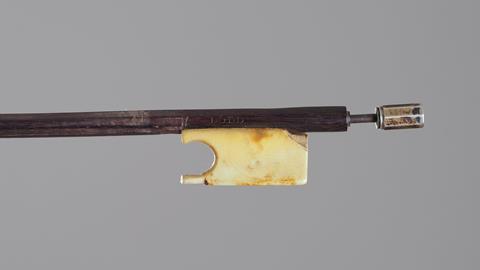
When my father failed to survive heart surgery in 2004, he left me with several questions to solve. That he was determined to recover from his illness was crystal clear, since the weekend before he went to hospital, it had proved an absolutely futile mission for me to try and scrounge some cello wood: ‘I will need that when I’m better.’
One of the biggest surprises, when I reluctantly had to dismantle his workshop, was the immense number of boxes of old bows I found, some even serving as an integral part of the workshop furniture. Most of these bows were worthless rubbish whose owners he had preferred to sell new bows to, since he was never keen on bow rehairing/repair. Among others, however, was what amounted to an interesting collection of old English bows, although these were ‘camouflaged’ by being mixed randomly in boxes of junk.
For a violin restorer who has worked near Vienna since the mid-1980s, sorting out a selection of cranky old English bows is, to put it mildly, a pretty esoteric assignment. The literature isn’t dreadfully helpful either. By far the best material I found was the bow section of the BVMA Catalogue of the 1995 Exhibition at the Royal Academy, written by Tim Baker. Unfortunately Tim listed the bows in alphabetical order, which is useful if you are looking for one particular maker but hinders one in getting a feeling for their development over time.
So I sifted through Tim’s bow chapter, reorganised it from alphabetical into chronological order, and identified 42 ‘features’ or idiosyncrasies that were characteristic of particular periods. With this I created a kind of ‘ready reckoner’ chart to work out which bows could be from when, and if parts were missing, what the missing part should look like. When I was finished I was quite surprised to see that one could draw some important conclusions from it.
Firstly, when confronted with old English bows, compilers of nearly all old books, auction catalogues etc. cite an estimated year of manufacture that is far too early. If one were to stand back a little in order to see the wood for the trees, one could see that English bows in the late 18th and early 19th centuries were in a state of flux, and only started conforming to ‘European standard’ around the middle of the 19th century (I would suggest with William Tubbs). One might wonder how much the political situation of the period with the continental blockade had to do with this.
This insight is in contradiction with the perception of many ‘authentic’ performers, who postulate a cut-off time for ‘Baroque’ musical performance and hardware around 1760, almost a hundred years previously.
Although dating instruments can be problematic, dating bows is infinitely more difficult (still), because bows do not have (dated) labels. (Mind you, violin labels can be an immensely treacherous subject, if I may veer of at a tangent for just a second.) Most early English bows seem to have been anonymously supplied unbranded to the violin trade, and were often stamped by the violin maker or dealer who retailed them (i.e. Warmsley, Forster etc.). In many cases, the period that a violin maker or shop was in business is known, and this is an important aid to rough-dating the bows that they supplied. One might even suppose that the stamps on these bows were more an advertisement for the retail shop than a signature from the person who actually made the bow. This was a worldwide practice until fairly recently.
To define how one identifies these early English bows, many of which are unstamped, one requires a mental list of their features – or, as I put it earlier, idiosyncrasies. A short selection of these features, in no particular order, would be:
• no faceplate on the head (pre-1790) – an important consideration for the modern bow service person)
• frogs (often ivory), mostly slightly narrower than the stick
• the stick mortise normally nearer to the adjuster than one might expect of a modern bow, so that one may often still see the back of the mortise even when the frog is mounted
• uneven width of facets on octagonal sticks, the top, bottom and side facets tending to be narrower than the 45-degree facets
• typical square-head mortise with a slit at the front to enable an adequate width of hair ribbon, terminus technicus: ‘top hat mortise’, this feature frequently ‘corrected’ by future rehairers who were unaware of its uniqueness
Finally, these makers seemed to be loath to throw any wood away. Wood blemishes were filled out, grafted and the like. Also the use of a plane was occasionally evidently not part of their nature, with them taking resort to the use of files. (These last two points are both sources of disbelief/contempt among modern Markneukirchen/Schönbach craftsmen, who have spent their lives making bows.)
I think it important to emphasise that the chart should be regarded as an approximate guide only. In particular, the practice of using cheaper (nickel) mounts on cheaper bows, as seen on the Continent, was not used in England, which complicates dating, because the English strategy for the lower budget clientele was to dispense with metalwork (and faceplates) altogether, and continue making open trench bows.
Also the date upon which a 'feature' on the chart finishes may not under any circumstances be taken as gospel. The same is true of violin making, where it can be irritating to hear that a post-1800 violin 'isn't Baroque', since many more senior violin makers continued to make violins to the same specifications that they had learnt in the 18th century, as young boys, until well into the 19th century.
At this point I would like to introduce a selection of these bows, I hope in chronological order, and invite readers who got this far down the page to check (with the help of my chart) if my attempt to date them could be plausible.
(A) Early cello bow, 70g
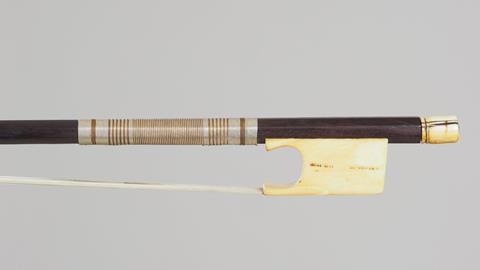
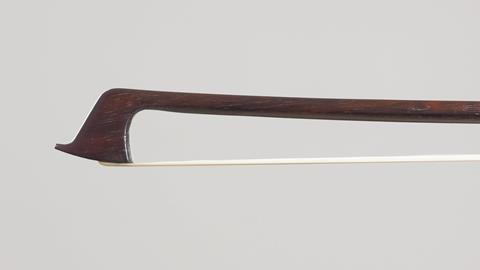
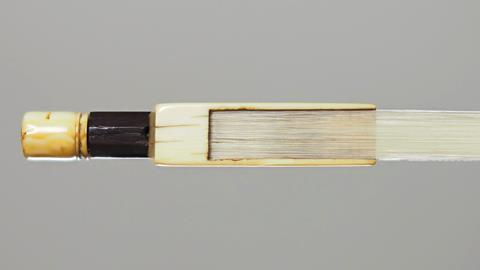
This early cello bow is still from the pre-faceplate era. I am told by various knowledgeable people that it is made of padauk, commonly known at the time as barwood or camwood. Both barwood [pterocarpus soyauxii] and camwood [baphia nitida] were used as commercial dye woods. The flat-sided open ivory frog is slightly narrower than the stick, and the stick mortise looks out beyond the frog. I wondered for a long time if the marks on both sides in the centre of the frog were the remains of a brand, but have come to the conclusion that somebody damaged it by cramping it in a metalwork vice. Should one have any trust in my chart, one could date it, from its features, as early as 1770, although it is more probable that it could have been an example of cheaper production well into the 19th century.
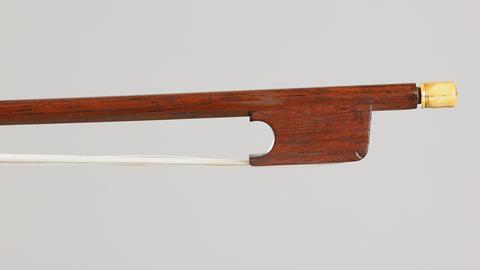
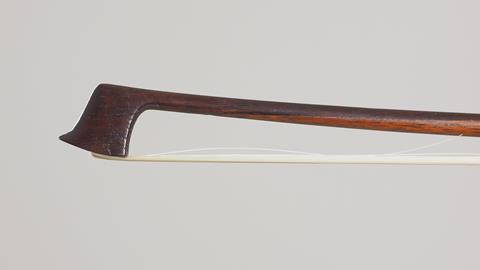


(B) Early violin bow, 51g
When one looks at old violin bows in museums and exhibitions, one only gets to see the choice bows that were cherished and looked after, and thus survived. I had often wondered what the bows of the impoverished tutti violinist of the 18th or early 19th centuries might have looked like, never mind the vagabond pub violinist who surely also had a bow. Since I am not aware of a second example anywhere, it is hardly scientific to postulate that this is such a bow, although I suggest it is. The flat-sided open trench frog, somewhat narrower than the stick, is made of mahogany and varnished with a thick coat of shellac. The lower two-thirds of the stick are also from mahogany, presumably due to economy rather than choice, whereas the upper third is made of padauk (see above) spliced on with a long joint. Quite why is another question. Was the plank of mahogany too short, or did the bow maker consider the upper part of the stick ‘more important’, necessitating a ‘better’ bow wood? This bow is also of the pre-faceplate era, the head roughish with not much of a nose. The chart would suggest an 18th-century origin, roughly contemporaneous with the padauk cello bow, although I cannot exclude that there wasn’t a demand for these budget bows for much longer, nor that this bow wasn’t made some time well into the 19th century. The stick is of rather stout proportions, I assume because mahogany is less dense. Although in danger of initially being dismissed by me in my hurry as junk and not worth the effort of rehairing, it is precisely for this bow that I get besieged by leading Austrian Baroque musicians, although I do not wish to part with it.
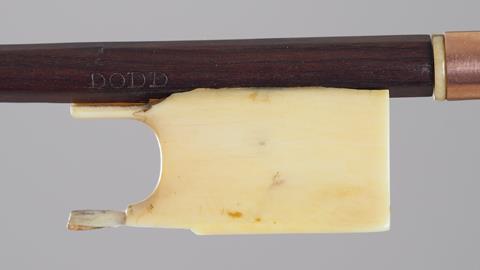
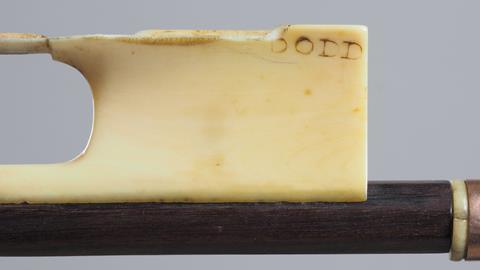
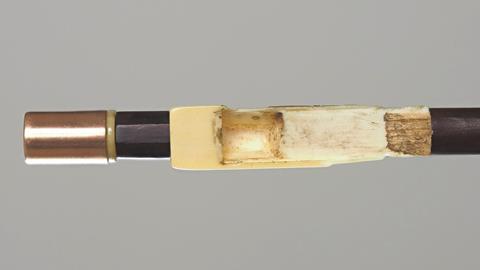
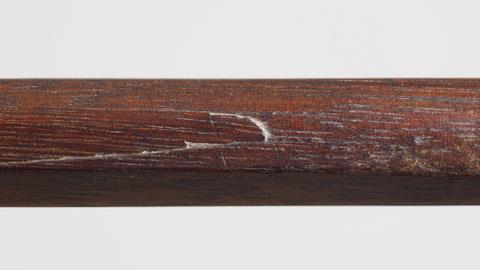
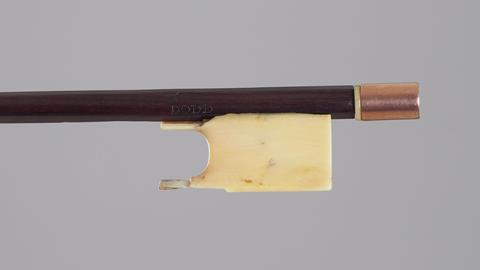
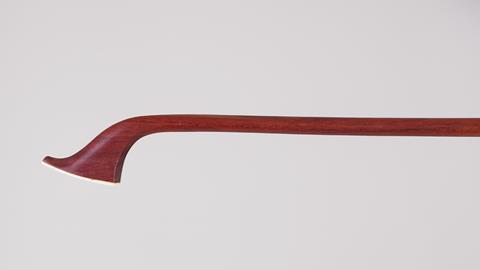


(C) Violin bow, John Dodd, late 18th century, 47g (without hair etc.)
Tim Baker illustrates a similar Dodd bow, which he dates c.1800 on page 362 of the BVMA book (exhibit #16). The bow shown here is of the period before the ivory faceplate was extended upwards at the tip, suggesting that this is a little older than Tim’s. It has large chamfers on the head and a pristine example of a ‘top hat’ mortise. I cannot swear on the Bible that it has the right frog, although this one was swimming around in the same box, and I believe it to belong to the bow. The (derelict) frog has deeply concave sides, and is narrower than the stick. There is an upside-down stamp ‘DODD’ at the bottom right corner of the reverse side of the frog, as well as the same stamp on the handle, roughly at the centre frog position. The stick mortise extends c.5mm beyond the frog in the untightened position. Alas, the adjuster has fallen foul of somebody who has been trying to ‘promote’ this bow anachronously into a gold-mounted bow, and who seems to have been caught red-handed before he finished. At the position on the stick where the lapping would be (if it had one), there has obviously been some large wood blemish that was removed and filled out with another bit of wood or offcut. Ultraviolet light reveals that this ‘repair’ was part of the original manufacture, owing to the uninterrupted varnish – a nice example of the enormous reluctance to discard good wood for such trifles.
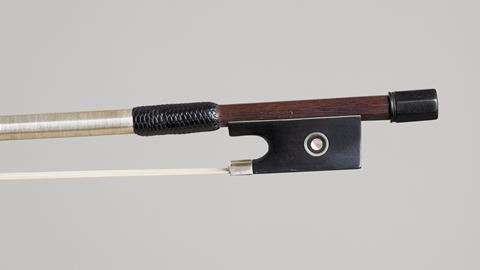


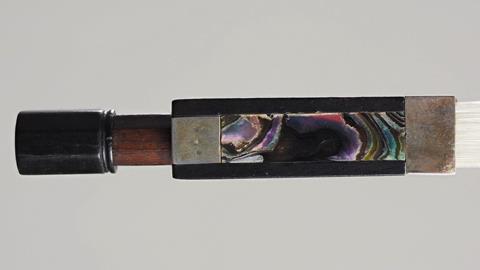
(D) Violin bow, Dodd, 60g
This is a very fine octagonal bow, again with wider 45-degree facets on the stick. It has an ivory faceplate without ebony lining, extended upwards at the tip. I presume that the head mortise was originally of the ‘top hat’ variety, but it has been ‘modernised’, so that one cannot tell any more. Again there is an (upside-down) stamp ‘DODD’ at the bottom right corner of the reverse side of the frog, as well as the same stamp on the handle roughly at the centre frog position. This time the stick mortise is only just covered by the frog when not under tension. The frog, which is the same width as the stick, has a bottom plate of nickel pinned once, although the other metalwork is silver. The frog has a small pearl eye embellished with a slightly lopsided silver ring. Please, nobody tell me that the ebony adjuster is from something else, because it was on the bow when I found it and I don’t have any other plausible one. After much agonising with my chart I thought that, all things considered, this bow could have been made in the mid-19th century.
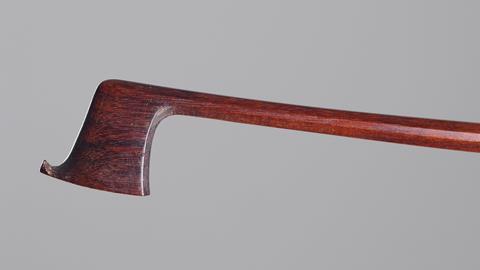
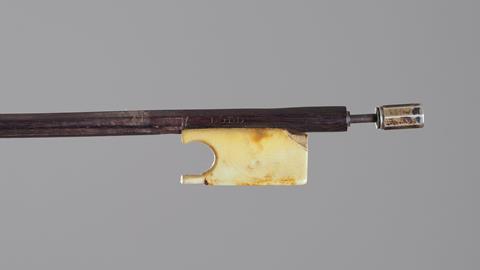



(E) Dodd violin bow, currently 50g without hair etc.
This bow seems rather similar to the previous one although with a (presumably original, but) derelict ivory frog this time. The faceplate is missing, and the question here would be whether to fit one with an ebony liner or not. It is still evident that the bow started life with a ‘top hat’ head mortise, although it has been somewhat worked upon to convert this into a more modern head mortise, a sort of halfway house. Again, the octagonal stick has the 45-degree facets slightly wider than the others, and a stick mortise that is just covered by the frog in ‘untightened’ (I know, nothing there to tighten) position. There is an (upside-down) stamp ‘DODD’ stamp in the usual place on the averagely concave sided ivory frog, as well as the same stamp on the handle, roughly at the centre frog position on the handle. Again, I realise that the adjuster is from elsewhere (Markneukirchen?), but this came with the bow, slightly rusted on. Again, after consulting my chart I would guess that it might have been made c.1820.
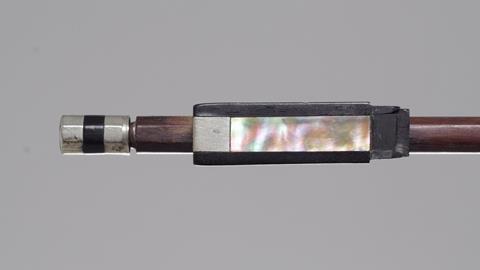

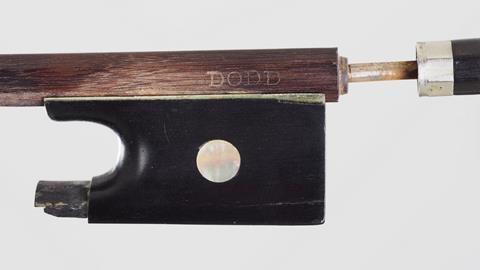
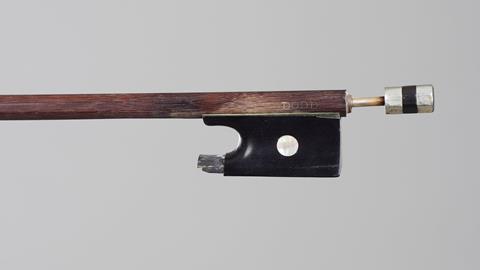
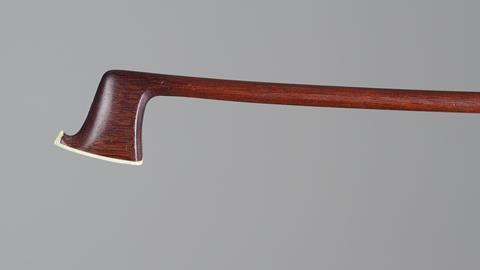
(F) Round violin bow, stamped Dodd, 47g without hair etc.
This bow, representative of several in my father’s collection, has a fairly upright head profile with wide chamfers, a sharp ridge, and a more or less intact ‘top hat’ mortise in the original ivory faceplate without ebony liner. I cannot find the stick quite as impressive as the two previous octagonal ones though, and the stamp ‘DODD’ on the handle is to be found further towards the adjuster. The frog has no stamp, and indeed I would presume that it is one of many such bows that was remounted in the later 19th century, with a new nickel-mounted frog and adjuster supplied by the Markneukirchen trade or their English agents. At this point, one should state that ‘Dodd’ was a popular stamp in Markneukirchen. Indeed, on one visit to Bubenreuth I discovered two ‘Dodd’ stamps lurking in dark and dusty corners of a friend’s workshop. Many pre-World War One Markneukirchen bows stamped ‘Dodd’ are actually rather nice, but I don’t think one can speak of ‘copies’. Rather this was a meaningless brand to the artisan, if a prestigious name for the dealers. Nor were the French averse to stamping ‘Dodd’ on their work (C. N. Bazin, for instance), which all goes to underline the importance of internalising the features and idiosyncrasies of the English bow. The absence of the original frog robs us of many features to look up on the chart, although with the remaining clues, I would suggest that it were made c.1840.
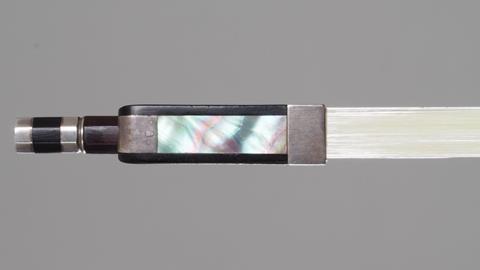
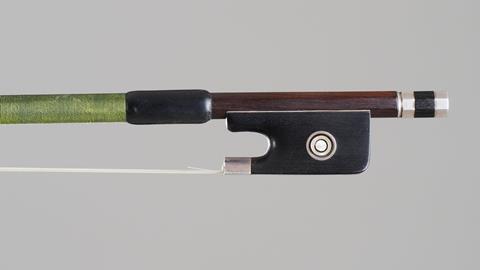

(G) Thomas Tubbs cello bow, 76g
Tim Baker illustrates a similar Thomas Tubbs cello bow as exhibit #34 on page 376 of the BVMA book, stamped ‘Betts’. He dates his example at c.1840. His bow has a silver faceplate without ebony lining, so I presume that the one I illustrate here is some years afterwards, since it has a silver faceplate with an ebony lining, a later development. Tubbs’s system of a pearl slide that goes through the whole ferrule, rendering a spreader wedge superfluous, has been eradicated (or modernised, depending upon your point of view). The double pearl eye in the frog illustrated in Tim’s example is repeated here, and further embellished with an additional silver ring. The upright, squarish head is interchangeable with the BVMA illustration, as is the three-piece adjuster, which to my uninformed eye would hardly look out of place on an old Weichold. The eight facets on the octagonal stick are by this time all of roughly equal width. The frog is stamped on the lower reverse side ‘Forster’ (upside-down), which by a process of elimination would mean that Simon Andrew Forster was the salesman. This bow nicely demonstrates how the features of the English bow and the continental bow began to converge by the middle of the 19th century.
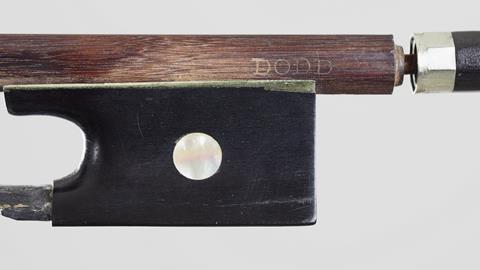
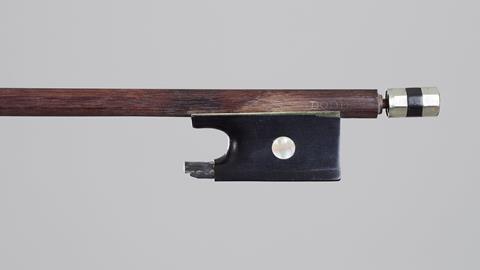
(H) W. Tubbs round violin bow, 54g
This bow is the odd one out here, since I didn't find it at my father’s workshop. Rather, back in the early 1980s I bought 'A violin by Ficker with bow in case' at Christie's – this was the 'bow in case', and a rare stroke of luck. I include it here since I feel that while it retains an English feeling, it marks the end of the truly 'English Bow' as discussed here. After I had acquired the bow, still not quite wanting to believe it, I visited Derrick (Dietrich) Kessler, the then owner of Withers in Wardour Street. He went and rummaged in the basement, and gleefully came back up to the workshop with a box containing about 20 William Tubbs bows. The frog and adjuster that came with the bow from Christie's was a wretched Schönbach replacement, so I had Matthew Coltman, who worked for Withers at the time, make me a copy of a real one for it.
And at this point I feel that the usefulness of my chart ends. The only English bow maker in the last part of the 19th century that I am aware of is James Tubbs, although I would be surprised if there weren’t others. It could be that the English violin makers and dealers found it easier and more lucrative during this period to import continental bows. A new chapter of English bow making was soon to be opened up with the advent of the ‘Hill bow’, which has already been documented exhaustively, notably in the writings of Richard Sadler.
I hope that, by having worked out and published my ‘ready reckoner’ chart to sort out these old 18th- and 19th-century English bows, I have helped anybody who should unwittingly become the owner of such a selection. In particular I hope that I have spared them the feeling that I had to start with – namely that of an ox staring at a mountain.
All photos Franz Karl
Downloads
Britishbow1
PDF, Size 18.87 kb























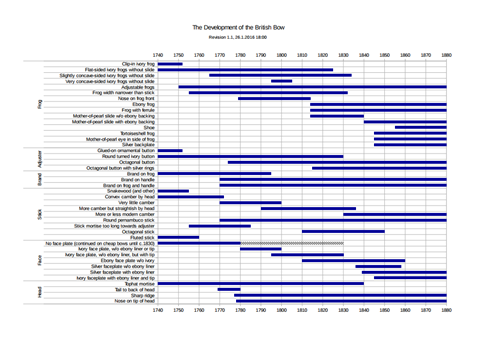

















No comments yet